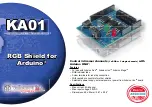
PSoC CY8CTMG20x and CY8CTST200 TRM, Document No. 001-53603 Rev. *C
113
Digital Clocks
14.2.2
OUT_P0 Register
This register enables specific internal signals to be output to
Port 0 pins. The GPIO drive modes must be specified to
support the desired output mode (registers PRT0DM1 and
PRT0DM0). If a pin is enabled for output by a bit in this reg-
ister, the corresponding signal has priority over any other
internal function that may be configured to output to that pin.
Bit 7: P0P7D.
‘0‘ selects main system clock (SYSCLK).
‘1‘ selects TrueTouch signal depending on PRS_CR and
CS_CR0 register settings.
Bit 6: P0P7EN.
This bit enables pin P0[7] for output of the
signal selected by P0P7D. ‘0 ‘is no internal signal output to
P0[7]. ‘1‘ outputs the signal selected by P0P7D onto P0[7].
Bit 5: P0P4D.
‘0‘ selects Timer Output (TIMEROUT). ‘1‘
selects CLK32.
Note
: During sleep mode these outputs will not be passed
through to P0[4].
Bit 4: P0P4EN.
This bit enables pin P0[4] for output of the
signal selected by P0P4D. ‘0‘ is no internal signal output to
P0[4]. ‘1‘ outputs the signal selected by P0P4D onto P0[4].
14.2.3
OUT_P1 Register
The Output Override to Port 1 Register (OUT_P1) enables
specific internal signals to output to Port 1 pins. If any other
function, such as I2C, is enabled for output on these pins,
that function has higher priority than the OUT_P1 signals.
Bit 7: P16D.
Bit selects the data output to P1[6] when
P16EN is high. In CY8CTMG20x and CY8CTST200 Timer
Output and CLK32 are available on P0[4] as well, but out-
puts on P0[4] will not be passed through during sleep
modes. Please refer to the OUT_P0 register for more
details.
0 - Select Timer output (TIMEROUT)
1 - Select CLK32
Bit 6: P16EN.
This bit enables pin P1[6] for signal output
selected by the P16D bit.
0 - No internal signal output to P1[6]
1 - Output the signal selected by P16D to P1[6]
Bit 5: P14D.
This bit selects the data output to P1[4] when
P14EN is high and 14DB is low.
Bit 4: P14EN.
This bit enables pin P1[4] for output of the
signal selected by the P14D bit.
Bit 3: P12D.
This bit selects data output to P1[2] when
P12EN is high. TrueTouch signals are available on P0[7] as
well. Please refer OUT_P0 register for more details.
Bit 2: P12EN.
This bit enables pin P1[2] for output of the
signal selected by the P12D bit.
Bit 1: P10D.
This bit selects data output to P1[0] when
P10EN is high.
Bit 0: P10EN.
Bit enables pin P1[0] for output of the signal
selected by the P10D bit.
0 - No internal signal output to P1[0]
1 - Output the signal selected by P10D to P1[0]
For additional information, refer to the
14.2.4
OSC_CR0 Register
The Oscillator Control Register 0 (OSC_CR0) configures
various features of internal clock sources and clock nets.
Bit 7: X32ON.
This bit enables the 32 kHz external crystal
oscillator (ECO) when set high. See the
Address
Name
Bit 7
Bit 6
Bit 5
Bit 4
Bit 3
Bit 2
Bit 1
Bit 0
Access
1,D1h
P0P7D
P0P7EN
P0P4D
P0P4EN
RW : 00
Address
Name
Bit 7
Bit 6
Bit 5
Bit 4
Bit 3
Bit 2
Bit 1
Bit 0
Access
1,DDh
P16D
P16EN
P14D
P14EN
P12D
P12EN
P10D
P10EN
RW : 00
Address
Name
Bit 7
Bit 6
Bit 5
Bit 4
Bit 3
Bit 2
Bit 1
Bit 0
Access
1,E0h
X32ON
Disable Buzz
No Buzz
Sleep[1:0]
CPU Speed[2:0]
RW : 01
Summary of Contents for PSoC CY8CTMG20 Series
Page 4: ...4 Contents Overview Feedback...
Page 26: ...26 PSoC CY8CTMG20x and CY8CTST200 TRM Document No 001 53603 Rev C Section B PSoC Core Feedback...
Page 82: ...82 PSoC CY8CTMG20x and CY8CTST200 TRM Document No 001 53603 Rev C Sleep and Watchdog Feedback...
Page 134: ...134 PSoC CY8CTMG20x and CY8CTST200 TRM Document No 001 53603 Rev C I2C Slave Feedback...
Page 142: ...142 PSoC CY8CTMG20x and CY8CTST200 TRM Document No 001 53603 Rev C System Resets Feedback...
Page 160: ...160 PSoC CY8CTMG20x and CY8CTST200 TRM Document No 001 53603 Rev C SPI Feedback...
Page 182: ...182 PSoC CY8CTMG20x and CY8CTST200 TRM Document No 001 53603 Rev C Full Speed USB Feedback...
Page 302: ...302 PSoC CY8CTMG20x and CY8CTST200 TRM Document No 001 53603 Rev C Glossary Feedback...
















































